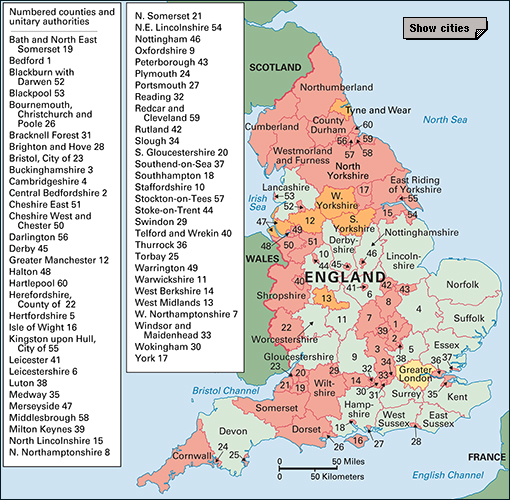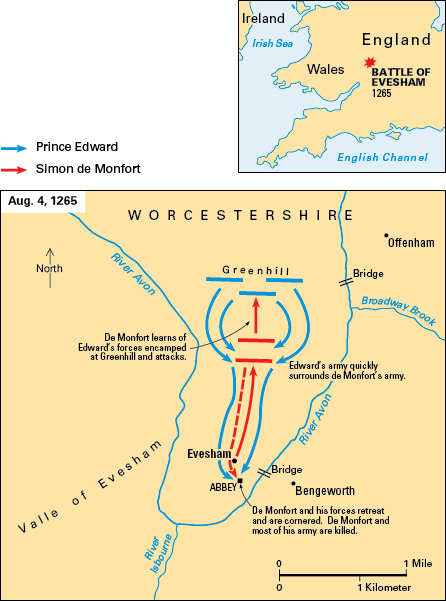Worcestershire << WUS tuhr SHIHR >> (pop. 603,676) is a county in west-central England. It is one of the oldest counties in England. From 1974 to 1998, it was part of a county called Hereford and Worcester. In 1998, it again became Worcestershire, and the district of Hereford was made a separate unitary authority under the title Herefordshire.

Worcestershire has areas of beautiful countryside, such as the Malvern Hills, in the west of the county. It has manufacturing and light industrial areas in the north and west, and the fruit-growing area of the Vale of Evesham in the southwest. The administrative center is the historic cathedral city of Worcester, in the center of the county.
People and government
Local customs.
Unusual customs in renting land still survive among the vegetable farmers in the Evesham area. A tenant who wishes to leave has the right to introduce a new tenant to the landlord at any time. If the new tenant has good references, the landlord must accept the new tenant or pay out the old tenant. Paying out involves giving the old tenant a large sum to end the tenancy. The sum is related to the value of the land, including any improvements that the old tenant has made. Tenants are almost as secure as if they owned the land.
Droitwich was a well-known salt-producing town, and its Brine Baths made it a fashionable spa town in the 1800’s. Bathing in Droitwich brine to cure ailments came back into fashion in the late 1900’s.
Recreation.
Amateur soccer teams in the county include those in Redditch, Worcester, Kidderminster, and Bromsgrove. Worcester has a rugby team. Cricket is popular in the area. Worcestershire County Cricket Club, a team known throughout England, is based at Worcester cricket ground. Worcester’s steeplechasing race course, Pitchcroft Meadow, is one of the oldest horse-racing courses in England.
River sports are well provided for in Worcestershire. There are rowing clubs at Bewdley, Evesham, Stourport, and Worcester. Many people fish in the Rivers Avon, Severn, and Teme.
The Three Choirs Festival of choral music takes place at Worcester Cathedral every third year, and there is an annual arts festival at Malvern. Worcester has several museums, including the City Art Gallery and Museum.
Local government.
The county council provides some of the public services throughout the county. Worcestershire is divided into six districts, whose councils provide other public services. The districts are Bromsgrove; Malvern Hills; Redditch; Worcester City; Wychavon, which includes Droitwich, Evesham, and Pershore; and Wyre Forest, which includes Kidderminster.
Economy
Agriculture.
Much of the farmland in Worcestershire is used for crop production, mainly grain crops such as wheat and rapeseed. Worcestershire is an important fruit-growing area. The main fruit-producing regions of the county are the Vale of Evesham, where there are many apple and pear orchards and other fruit and vegetable farms; Pershore, which specializes in plums; and the Teme Valley. Most growers produce apples, pears, raspberries, or strawberries.
Hops, used in brewing, are grown around Worcester, in the Teme Valley, and in the extreme south of the county. Farmers cultivate asparagus in the Vale of Evesham and sugar beet around Kidderminster.
Farmers raise some dairy cattle, hogs, and poultry, mainly in the south of the county.
Manufacturing.
Worcester is famous for its porcelain, produced at the Royal Worcester Porcelain factory. Lea and Perrins Worcestershire sauce was created in Worcester in the 1830’s and is still produced there. Kidderminster has been a center for the carpet industry since the 1800’s. It also has factories producing sugar from sugar beets. Redditch is a center for high-technology industry, and its engineering works supply many components for the automobile industry. The county produces sand, gravel, brick clay, and limestone.
Tourism.
Worcestershire’s beautiful scenery attracts many tourists. The Malvern Hills have superb views and are popular with walkers. The city of Worcester has many historic buildings.
Transportation and communications.
The M5 motorway (expressway) runs through the center of the county and connects it to the West Midlands and the South West. A mainline railroad from Birmingham to Bristol runs through Worcester and there are mainline trains to London, Cardiff, and Manchester.
A daily newspaper is published in Worcester. Most of the towns in the county publish weekly newspapers. An independent local radio station, Wyvern FM, serves the area around Great Malvern and Worcester.
The land
Location and size.
Worcestershire is one of the smallest counties of England. The longest north-south distance is about 34 miles (55 kilometers) and the longest east-west distance is about 39 miles (63 kilometers). 
Land features.
The Clent and Lickey hills rise in the north. The Clent hills reach 1,027 feet (313 meters). In the south are Bredon Hill, rising to 985 feet (300 meters), and the edge of the Cotswolds. The Malvern Hills, which rise to 1,395 feet (425 meters) at the Worcestershire Beacon, extend along the southwestern edge of the county, on the Herefordshire border.
Rivers and canals.
The largest river is the Severn. The Avon joins the Severn at Tewkesbury and flows through the Vale of Evesham. In the north, the Teme joins the Severn near Worcester. The Worcester and Birmingham canal runs through the northeast of the county, and it is joined by the Droitwich canal north of Worcester.
Climate.
Worcestershire is one of the United Kingdom’s warmest inland areas, with average temperatures of about 39 °F (4 °C) in February and 63 °F (17 °C) in July. Snow or sleet falls on only about 14 days in a year.
The county’s average rainfall is about 28 inches (71 centimeters). October and January are the wettest months. June is both the driest and the sunniest month.
History
The Romans founded the city of Worcester in about 100. The Danes invaded the area in the 900’s. In early Norman times, the church controlled most of the county.
In the Barons’ War, a rebellion against King Henry III led by Simon de Montfort, the barons were defeated by Prince Edward, later Edward I, at the Battle of Evesham (1265). More fighting occurred in the Wars of the Roses in the 1400’s.

In 1637, Worcester was ravaged by plague. In the English Civil War (1642-1648), the county was loyal to the Royalists, and Worcester was besieged in 1646. The city was plundered and the cathedral damaged at the Battle of Worcester in 1651.
Famous people associated with the county include the British prime minister Stanley Baldwin, who was born in Bewdley, and the composer Edward Elgar, who was born in Lower Broadheath, near Worcester.
